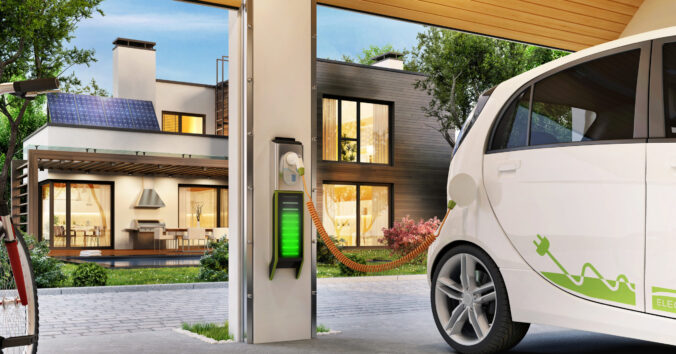Is the electric vehicle really greener?

Today’s society cares more and more about the environment. This is resulting in major changes that affect all industries. The automotive industry is obviously part of it and its challenges are numerous: recycling, the end of the thermal engine, new technologies…
The vast majority of European car manufacturers (such as Stellantis, Renault, Volkswagen, etc.) are constantly making some efforts to create new vehicles more environmentally friendly by electrifying them. In fact, a good number have announced the ban the internal combustion engines in their range by 2035.
In general, when we talk about the electric vehicle, it is often associated with less polluting than thermal vehicles (gasoline, diesel, etc.). But is it 100% true? This is what we will try to understand today.
The electric vehicle: a lower carbon footprint than the thermal vehicle
First of all, you have to understand that when we talk about the electric vehicle, it refers to an engine without thermal energy which lead to reducing of carbon emissions. Therefore, it is easy to say that in terms of carbon, the combustion engine vehicle emits much more CO2 than the electric car. A recent study by the European Federation for Transport and the Environment shows that electric vehicles can emit up to 79% less CO2 than gasoline or diesel vehicles.
When an electric vehicle is driving, it emits very little or no greenhouse gases, harmful gases or nuisances, which is not the case with a thermal vehicle which emits much more. Moreover, an electric vehicle does not have an exhaust, which technically makes it incapable of emitting CO2.
Green energy: a useful resource for recharging electric vehicles
Regarding the recharging of the electric vehicle, it can be done from renewable energy or “green” energy. Many players in France provide green electricity, which remains a much greener way than using gasoline or diesel to charge an electric vehicle. Charging an electric vehicle also requires a lower budget than filling it up at the pump.
In one year, the price of fuel has increased by 20% since 2020 in France. Thus, the maintenance of such vehicle is also less expensive than a thermal vehicle whose engine requires more effort in terms of care on the paper.
The reality is different, because the various actors of the sector (mechanics, car repairers) are not always trained and aware of new technologies. Although the bill should be smaller on the paper, reality tends to prove that servicing an electric vehicle can be costly money and not easy to find.
Battery recycling is still widely practiced in Europe
Then comes the question of batteries. You should know that the battery is a central part of an electric car. This is why it seems important to recycle it when it is no longer usable for its main function. European manufacturers of electric vehicles have an obligation to recycle their batteries. This is particularly the case in France, in accordance with this European directive of 2006.
Thus, the majority of batteries used in electric (and thermal) vehicles are well recycled: they are sometimes entrusted to specialized companies which give them a “second life”. They can, for example, be reused to store renewable energy.
However, it is important to note that the recycling of batteries raises some other questions today. The number of recycled batteries remains low for the moment due to the low presence of electric vehicles in the automotive market. The electrification (partial or complete) of the ranges of car manufacturers will require many more years of effort. In addition, recycling batteries for electric vehicles currently remains unattractive from a financial point of view – it is costly.
Based on those information, we can globally deduce that the electric vehicle has a lower environmental impact overall than diesel or gasoline powered cars.
Finally, although the advantages seem numerous in favor of the electric vehicle (CO2 emissions, maintenance, etc.) to assess the real ecological footprint of a product (here the electric vehicle), it seems essential to take an interest in all of its cycle, from the production phase to its end of life. And that’s what we’ll see in details.
The production of an electric vehicle, a not so “clean” process
Contrary to what we might think, producing an electric vehicle can actually be much more polluting than producing a thermal vehicle. The CO2 emissions are in fact 30% higher for the production of an electric vehicle than for a thermal one and this can be explained by several factors.
First of all, the manufacture of batteries for electric vehicles requires raw materials called “rare earths” such as lithium, cobalt or graphite. Their extraction involves the use of large quantities of water and chemicals that have negative impacts on the environment.
In addition, you should know that the main mining companies are not located in Europe. Indeed, these metals come in particular from China, the Democratic Republic of Congo and South America. The environmental and sometimes societal impact is therefore concentrated in those areas. Not to mention the assembly of these batteries which also turns out to be very costly for the environment because they are prepared in very high voltage furnaces which have a very high energy consumption.
An electric vehicle generates fine polluting particles when driving
Although an electric car does not have an exhaust, it does not necessarily mean that it does not pollute at all when driving. In fact, each time a driver presses the brake pedal, this causes friction between the pads and the vehicle disc which results in the rejection of dust or “fine particles”.
Braking alone is responsible for 20% of road traffic particles. Indeed, the abrasion of tires, road surfaces and brakes play a major role in the emission of these fine particles. However, it should be kept in mind that exhaust gases and reducing CO2 remain the main priority of the French (and European) authorities because they pollute much more than these fine particles.
Electricity: an energy that is not always made in a green way.
Electricity is obviously the main resource to use to charge your electric car, but not all countries are able to produce green or renewable electricity, and therefore respect the environment. Indeed, the ecological footprint largely depends on the way in which the electricity used in the vehicle comes from.
As for France, it is rather gifted in this area. Electricity comes mainly from nuclear, which allows it to emit very little CO2 on average, although the use of nuclear is controversial. The production of electricity used for electric vehicles is therefore carbon-free. However, nuclear power cannot be considered as clean energy because of the radioactive waste it generates, which has negative consequences not only on the environment but also on health.
As for China, a major electric car market, electricity comes mainly from coal-fired plants which contribute significantly to the country’s CO2 emissions. The use of electric vehicles on a large scale would therefore lead to a significant increase in air pollution in the region.
Note that a coal-fired power plant emits 40% more CO2 than a gas plant producing the same amount of electricity. Coal is responsible for 75% of the carbon emissions of the European electricity sector, although it only generates 25% of our electricity.
All of this shows that countries need to redouble their efforts to find solutions and alternatives to produce electricity in the “cleanest” way possible. It also requires better knowledge of the environment surrounding the electric vehicle as a whole.
SNECI : Green mobility facilitator for Automotive Industry
This is why at SNECI, expert company in industrial performance and international business development, we offers various specialized training courses on support in the production of electric vehicles to several hundred customers worldwide.
Provided by our experts, our training TS01: Electric Vehicle Technology: Components and Operation for example, allows you to discover the technological world of the electric vehicle in its ecosystem with its specificities by market. This training will also provide you with solid knowledge on the evolution of services related to the electric vehicle for a better understanding and anticipation of developments. You can also find all of our trainings here.
In addition, SNECI is also well aware of the importance that batteries will take on for years to come, as they are essential for the manufacture of electric vehicles. This is why we are strengthening our skills in battery industrialization in order to support our customers as well as possible.
To conclude, we can say that the electric vehicle remains much less polluting than the thermal vehicle in terms of CO2 emissions. However, there is still a large number of factors on which it is necessary for the automotive industry to work to find lasting and sustainable solutions (use of rare metals, recycling of batteries, abrasion, etc.), which still requires a lot of efforts from manufacturers, suppliers, as well as public actors (governments, regional institutions, etc.).
Without forgetting that there is the question of charging stations, the recharging time but also the battery life.
You will understand that the electric vehicle, although it has many advantages, does not guarantee 100% ecological production, but it is a step forward towards a greener and more eco-responsible automotive industry.
At SNECI our commitment to the environment is important, we are developing numerous partnerships with “green” players in the sector to provide the best solutions to our customers in many industries.
We are committed to working with players committed to repairing the world in the future, both in the modernization of factories, in the improvement of processes or in support for a greener industry.
If you would like one of our experts to get in touch with you and support you in your industrial performance improvement projects or in your business development in France or internationally, do not hesitate to contact us!






